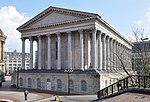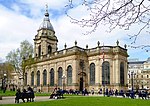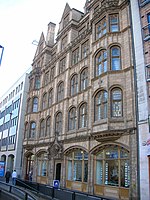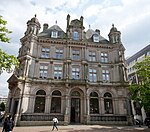Town Hall tram stop
Railway stations in Great Britain opened in 2019Tram stops in Birmingham, West Midlands

Town Hall tram stop is a tram stop on Line 1 of the West Midlands Metro located in Birmingham outside the Birmingham Town Hall. It opened on 11 December 2019 when the line was extended from Grand Central to Birmingham Library.In July 2022 the line was further extended to Edgbaston Village.
Excerpt from the Wikipedia article Town Hall tram stop (License: CC BY-SA 3.0, Authors, Images).Town Hall tram stop
Victoria Square, Birmingham Ladywood
Geographical coordinates (GPS) Address Nearby Places Show on map
Geographical coordinates (GPS)
| Latitude | Longitude |
|---|---|
| N 52.4793 ° | E -1.9034 ° |
Address
Town Hall
Victoria Square
B3 3DQ Birmingham, Ladywood
England, United Kingdom
Open on Google Maps










